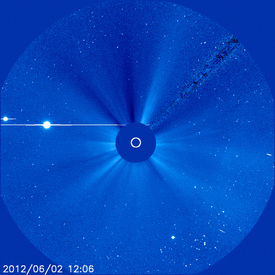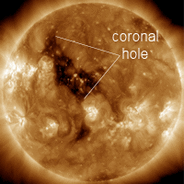| A 24-hour movie shows that Mercury is exiting stage left as Venus plunges deeper into sunlight. Updated images may be found here. Amateur astronomers who manage to locate Venus in broad daylight will find that the planet has turned into a delightfully slender crescent. This is happening because Venus is turning its nightside to Earth, with only a sliver of reflected sunlight still shining over the planet's limb. The crescent could soon become a ring. When Venus is less than few degrees away from the sun, the horns of the crescent sometimes reach around and touch, producing a complete annulus. The effect is caused by particles in upper layers of Venus's atmosphere which scatter sunlight around the circumference of the planet. The ring is very difficult to observe, and often only black-belt astrophotographers are able to record the phenomenon. Keep an eye on SpaceWeather's realtime photo gallery to see how Venus shape-shifts in the days ahead. |
| CORONAL HOLE: Spewing solar wind, a yawning dark fissure in the sun's atmosphere is turning toward Earth. NASA's Solar Dynamics Observatory photographed the "coronal hole" during the early hours of June 1st. Coronal holes are places where the sun's magnetic field opens up and allows the solar wind to escape. A stream of solar wind flowing from this coronal hole will reach Earth on June 5th - 7th, possibly stirring geomagnetic storms. High-latitude sky watchers should be alert for auroras. www.spaceweather.com. |


 RSS Feed
RSS Feed